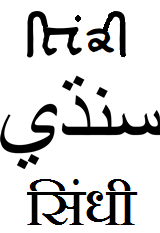Language/Sindhi/Grammar/Adjectives-and-Adverbs
Introduction
Welcome back to the Complete 0 to A1 Sindhi Course. In this lesson, we will be discussing the two important parts of speech in Sindhi grammar: adjectives and adverbs.
Adjectives are words that describe or modify nouns, while adverbs are words that modify verbs, adjectives, and other adverbs. Understanding how to use adjectives and adverbs correctly is crucial to effectively communicating in Sindhi. By the end of this lesson, you will learn how to form and use adjectives and adverbs in simple sentences.
Adjectives in Sindhi Grammar
In Sindhi, adjectives usually come after the noun they describe. Unlike languages such as English or French, adjectives are not declined in gender or number according to the noun they describe. Instead, adjectives in Sindhi usually take the same form regardless of the gender, number or case of the noun they describe. Let's look at some examples:
| Sindhi | Pronunciation | English |
|---|---|---|
| اچی | acchi | Good |
| کــــُـــــــــــــــدار | kudar | Smart |
| ســـُــــــــــرمايــن | surmayan | Beautiful |
| ٻڌو | bhadho | Old |
Note that adjectives are formed in the same way regardless of the gender and number of the noun. Additionally, Sindhi adjectives cannot be used alone as independent words. They must always modify a noun or pronoun in a sentence.
Adverbs in Sindhi Grammar
Adverbs, on the other hand, modify verbs, adjectives or other adverbs in a sentence. They provide additional information on the manner, time, place or degree of an action, attribute or another adverb. In Sindhi, adverbs usually come after the word they modify.
Here are some examples of adverbs in Sindhi:
| Sindhi | Pronunciation | English |
|---|---|---|
| پٺــــــــو | petho | afterwards |
| سڀتـــــــــــا | sabta | Always |
| جــــــــــنهن | janaan | Already |
| واقعـــــا | wakiaa | Really |
In Sindhi, adverbs are not declined according to the tense or mood of the verb they modify. They remain the same in all tenses, moods, and persons.
Formation of Adjectives and Adverbs in Sindhi
As we have seen above, adjectives and adverbs in Sindhi do not decline in gender or number. Instead, they are formed using suffixes or particles. Here are some common suffixes and particles used to form adjectives and adverbs in Sindhi:
Suffixes Used to Form Adjectives
- -يل (yel) – adds an abstract or figurative meaning to a word; for example, "جامه" (jamaho) means "shirt", but "جامهيــــــل" (jamayel) means "official attire" or "costume." - -وــــــن (wan) – adds the meaning of "full of" or "having"; for example, "رَنڻــــوُن" (ranwan) means "colorful", or "full of colors." - -ــکـــــــــو (ko) – used to describe physical and emotional states or conditions; for example, "ميوٽ" (miyut) means "dead," but "ميوٽـــــــــــکـــــــــــو" (miyutko) means "depressed."
Particles Used to Form Adverbs
- هـــــــي (hey) – adds the meaning of "there" or "at that place," as in "اھـــي" (ahi), meaning "there." - ـــــــــــن (an) – used to add the meaning of "thus" or "in this way," as in "سڀان" (saban), meaning "all," whereas "سڀــــــــــن" (saban) means "in this way" or "thus." - هـــــــا (ha) – used to add the meaning of "already" or "just," as in "هــــــل پونو بارڻــــــــــت (heil pono baranat)", meaning "he has already plowed the field"
Using Adjectives and Adverbs in Sentences
In Sindhi, adjectives always come after the noun they modify. When multiple adjectives are used, they come in the order of the following categories: color, size, appearance, shape, age, origin, material, and purpose.
For example, instead of "a green long dress," Sindhi would say "لَـــائـــل گهٽــــو ڪپڙو" (lail ghatta kapro), implying that the dress is long then green.
Adverbs, on the other hand, come after the verb they modify. Here is an example:
- "توهان وَٽُوجِ وَاڌَي ٿٺــــــــا" (tohan watooji wajay theenda) - meaning "You sang beautifully"
Note how the adverb وَاڌَي (wajay) has been placed after the verb وٽــــُوجِ (watooji), meaning "sang."
Conclusion
In this lesson, we have discussed Sindhi adjectives and adverbs, how to form them, and how to use them in sentences. You have learned about common suffixes and particles used to form adjectives and adverbs, the order of adjectives in a sentence, and where to place adverbs in relation to verbs. You can now use these concepts to construct simple sentences with ease. Keep practicing and come back to the next lesson where we will be discussing Sindhi verbs and tenses.

